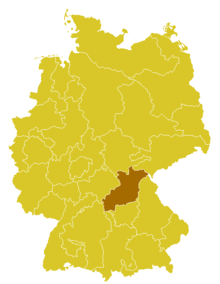- Roman Catholic Archdiocese of Bamberg
-
Archdiocese of Bamberg
Archidioecesis Bambergensis
Erzbistum Bamberg
Bamberg CathedralLocation Country Germany Ecclesiastical province Bamberg Metropolitan Bamberg, Bavaria Statistics Area 10,290 km2 (3,970 sq mi) Population
- Total
- Catholics(as of 31 December 2008)
2,076,801
750,545 (38.4%)Parishes 310 Information Denomination Roman Catholic Rite Roman Rite Established 1 November 1007 Cathedral Bamberg Cathedral Patron saint St. Cunegundes
St. Otto of Bamberg
St. Henry IICurrent leadership Pope Benedict XVI Archbishop Ludwig Schick
Archbishop of BambergAuxiliary Bishop Werner Radspieler Emeritus Bishops Karl Heinrich Braun Map 
Website eo-bamberg.de The Archdiocese of Bamberg (lat. Archidioecesis Bambergensis) is a diocese of the Roman Catholic Church in Bavaria and is one of 27 Roman Catholic dioceses in Germany. About a third[1] (actually 38,1 % in 2006) of the population is Catholic. With 15.6% this diocese has one of higher (relative) numbers of worshippers on Sunday in Germany. It comprises the majority of the administrative regions of Upper Franconia and Middle Franconia, as well as a small part of Lower Franconia and the Upper Palatinate. Its seat is Bamberg. The dioceses of Speyer, Eichstätt, and Würzburg are subordinate to it. The Diocese was founded in 1007 out of parts of the dioceses of Eichstätt and Würzburg. In 1817, the diocese was raised to an archdiocese.
History
At 1 November 1007 a synod was held in Frankfurt. Eight archbishops and twenty-seven bishops were present at the synod as well as the German King Henry II. Henry II intended to create a new diocese that would aid in the final conquest of paganism in the area around Bamberg. But the territory of the Wends on the upper Main, the Wiesent, and the Aisch had belonged to the Diocese of Würzburg since the organization of the Middle German bishoprics by St. Boniface, so that no new diocese could be erected without the consent of the occupant of that see.
The bishop of Würzburg raised no objection to parting with some of his territory, especially as the king promised to have Würzburg raised to an archbishopric and to give him an equivalent in Meiningen. The consent of Pope John XVII was obtained for this arrangement, but the elevation of Würzburg to an archbishopric proved impracticable, and its bishop withdrew his consent.
At the synod Henry obtained permission for the foundation of the diocese of Bamberg from parts of the dioceses of Würzburg and Eichstätt. Bamberg was made directly subordinate to Rome. It was also decided that Eberhard, the king's chancellor, would be ordained by the archbishop of Mainz, Willigis, to be the head of the new border area diocese. The new diocese had expensive gifts at the synod confirmed by documents, in order to place it on a solid foundation. Henry wanted the celebrated monkish rigour and studiousness of the Hildesheim cathedral chapter - Henry himself was educated there - linked together with the churches under his control, including his favourite diocese of Bamberg. The next seven bishops were named by the emperors, after which free canonical election was the rule. Eberhard's immediate successor, Suidger of Morsleben, became pope in 1046 as Clement II. He was the only pope to be interred north of the Alps in the Bamberg Cathedral. In the thirteenth century the diocese gradually became a territorial principality, and its bishops took secular precedence next after the archbishops; Bishop Henry I was the first prince-bishop.
The fortieth bishop, George III of Limburg (1505-22), was inclined toward the Reformation, which caused a violent social outbreak under his successor Weigand (1522-56), and the city suffered severely in the Margraves' War (1552-54), as well as in the Thirty Years' War, when it was placed under the jurisdiction of Bernard, the new Duke of Franconia.
At the Peace of Westphalia (1648), the bishops recovered their possessions; but these were overrun by the French revolutionary armies, and in 1802 annexed to Bavaria. From 1808 to 1817 the diocese was vacant; but by the Bavarian Concordat of the latter year it was made an archbishopric, with Würzburg, Speyer, and Eichstädt as suffragan sees.
For a list of archbishops, see Archbishop of Bamberg.
See also
References
 This article incorporates text from a publication now in the public domain: Jackson, Samuel Macauley, ed (1914). "article name needed". New Schaff-Herzog Encyclopedia of Religious Knowledge (third ed.). London and New York: Funk and Wagnalls.
This article incorporates text from a publication now in the public domain: Jackson, Samuel Macauley, ed (1914). "article name needed". New Schaff-Herzog Encyclopedia of Religious Knowledge (third ed.). London and New York: Funk and Wagnalls.- Official German Catholic Church Statistics website
- Official site
- Standard Catalog of World Coins, 5th Edition
Roman Catholic dioceses in Germany Province of Bamberg Province of Berlin Province of Cologne Province of Freiburg Province of Hamburg Province of Munich and Freising Province of Paderborn Sui iuris Jurisdictions Categories:- Roman Catholic dioceses in Germany
- 1007 establishments
- Bishops of Bamberg
- Roman Catholic dioceses established in the 11th century
Wikimedia Foundation. 2010.

